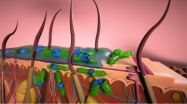(Press-News.org) PHILADELPHIA — Treating the rare disease MPS I is a challenge. MPS I, caused by the deficiency of a key enzyme called IDUA, eventually leads to the abnormal accumulation of certain molecules and cell death.
The two main treatments for MPS I are bone marrow transplantation and intravenous enzyme replacement therapy, but these are only marginally effective or clinically impractical, especially when the disease strikes the central nervous system (CNS). Using an animal model, a team from the Perelman School of Medicine at the University of Pennsylvania has proven the efficacy of a more elegant way to restore IDUA levels in the body through direct gene transfer. Their work was published this week online in Molecular Therapy.
"The study provides a strong proof-of-principle for the efficacy and practicality of intrathecal delivery of gene therapy for MPS patients," said lead author James M. Wilson, MD, PhD, professor of Pathology and Laboratory Medicine and director of the Penn Gene Therapy Program. "This first demonstration will pave the way for gene therapies to be translated into the clinic for lysosomal storage diseases."
This family of diseases comprises about 50 rare inherited disorders marked by defects in the lysosomes, compartments within cells filled with enzymes to digest large molecules. If one of these enzymes is mutated, molecules that would normally be degraded by the lysosome accumulate within the cell and their fragments are not recycled. Many of the MPS disorders can share symptoms, such as speech and hearing problems, hernias, and heart problems. Patient groups estimate that in the United States 1 in 25,000 births will result in some form of MPS. Life expectancy varies significantly for people with MPS I. Individuals with the most severe form rarely live more than 10 years.
The team used an adeno-associated viral (AAV) vector to introduce normal IDUA to glial and neuronal cells of the brain and spinal cord in a feline model. Their aim was to treat the CNS manifestations of MPS at the source. After a single injection of the AAV9 vector expressing a normal feline IDUA gene sequence and various promoters, the investigators collected blood serum and cerebrospinal fluid (CSF) samples from the test animals and from untreated controls
Some of the treated animals displayed a sharp decline in IDUA levels in the CSF after an initial elevation in the enzyme, which the researchers attribute to an antibody response against IDUA. However, IDUA still persisted at a level sufficient to elicit a positive therapeutic response.
The team also found that one CSF enzyme was elevated in the presence of MPS and propose it could be used as a biomarker for disease activity. All the treated animals displayed a marked decrease in this enzyme, confirming a definite biochemical response to the introduction of the gene vector.
Tissue samples from the brain and spinal cord showed widespread presence of the AAV9 vector throughout all regions of the CNS. IDUA deficiency in the CNS caused by MPS1 results in the accumulation of cholesterol and lipids called gangliosides in brain tissue and accumulation of the sugar glycosaminoglycan in connective tissue and cerebral blood vessels. The animals treated with the AAV9-IDUA vector displayed an almost complete reversal of these molecular markers of MPS.
"Signs of MPS were also virtually completely corrected in the liver and spleen," notes Wilson.
Even with a possible antibody response, conclude the researchers, a single injection nearly reversed all evidence of MPS pathology in the CNS of the treated animals. Next steps could include possible human trials and the expansion of this therapeutic approach to other lysosomal diseases that attack CNS cells.
INFORMATION:
Co-authors also included Mark E. Haskins from Penn School of Veterinary Medicine. This work was funded by NIH grants P40-OD010939 and DK25759 and ReGenX BioSciences, LLC, a Washington, D.C.-based biotech firm that holds licenses in technology used in this study.
Editor's Note:
J.M. Wilson is an advisor to ReGenX Biosciences and Dimension Therapeutics , and is a founder of, holds equity in, and receives grants from ReGenX Biosciences and Dimension Therapeutics; in addition, he is a founder, consultant and advisor to several other biopharmaceutical companies and is an inventor on patents licensed to various biopharmaceutical companies.
Penn Medicine is one of the world's leading academic medical centers, dedicated to the related missions of medical education, biomedical research, and excellence in patient care. Penn Medicine consists of the Raymond and Ruth Perelman School of Medicine at the University of Pennsylvania (founded in 1765 as the nation's first medical school) and the University of Pennsylvania Health System, which together form a $4.3 billion enterprise.
The Perelman School of Medicine has been ranked among the top five medical schools in the United States for the past 17 years, according to U.S. News & World Report's survey of research-oriented medical schools. The School is consistently among the nation's top recipients of funding from the National Institutes of Health, with $392 million awarded in the 2013 fiscal year.
The University of Pennsylvania Health System's patient care facilities include: The Hospital of the University of Pennsylvania -- recognized as one of the nation's top "Honor Roll" hospitals by U.S. News & World Report; Penn Presbyterian Medical Center; Chester County Hospital; Penn Wissahickon Hospice; and Pennsylvania Hospital -- the nation's first hospital, founded in 1751. Additional affiliated inpatient care facilities and services throughout the Philadelphia region include Chestnut Hill Hospital and Good Shepherd Penn Partners, a partnership between Good Shepherd Rehabilitation Network and Penn Medicine.
Penn Medicine is committed to improving lives and health through a variety of community-based programs and activities. In fiscal year 2013, Penn Medicine provided $814 million to benefit our community.
Attacking a rare disease at its source with gene therapy
Penn proof-of-principle animal study reduces harmful accumulation of proteins in lysosomal storage disease
2014-08-26
ELSE PRESS RELEASES FROM THIS DATE:
Unprecedented detail of intact neuronal receptor offers blueprint for drug developers
2014-08-26
Argonne, Ill.– Scientists succeeded in obtaining an unprecedented view of a type of brain-cell receptor that is implicated in a range of neurological illnesses, including Alzheimer's disease, Parkinson's disease, depression, schizophrenia, autism, and ischemic injuries associated with stroke.
The team of biologists at Cold Spring Harbor Laboratory used the U.S. Department of Energy's Advanced Photon Source at Argonne National Laboratory to get an atomic-level picture of the intact NMDA (N-methyl, D-aspartate) receptor should serve as template and guide for the design ...
Yale journal explores advances in sustainable manufacturing
2014-08-26
In recent years, increasing pressure from policymakers, consumers, and suppliers has prompted manufacturers to set environmental targets that go beyond reducing the pollutants they emit from their smokestacks or discharge into rivers and lakes. Today companies must also assess environmental performance at every step in their process, from the mining of primary materials to the use and recycling of their products.
This perspective has given rise to the discipline known as life cycle engineering, which connects the engineers who grapple with the efficiencies of production ...
Composition of Earth's mantle revisited
2014-08-26
Research published recently in Science suggested that the makeup of the Earth's lower mantle, which makes up the largest part of the Earth by volume, is significantly different than previously thought.
Understanding the composition of the mantle is essential to seismology, the study of earthquakes and movement below the Earth's surface, and should shed light on unexplained seismic phenomena observed there.
Though humans haven't yet managed to drill further than seven and a half miles into the Earth, we've built a comprehensive picture of what's beneath our feet through ...
What can 14th century Venice teach us about Ebola and other emerging threats?
2014-08-26
The way in which the Italian city of Venice dealt with the outbreak of the plague in the fourteenth century holds lessons on how to even mitigate the consequences of today's emerging threats, like climate change, terrorism, and highly infectious or drug-resistant diseases. So says Dr. Igor Linkov of the US Army Engineer Research and Development Center, and a visiting professor of the Ca Foscari University in Italy. Linkov led an article on resilience management appearing in Springer's journal Environment Systems and Decisions.
Venice was the hub of many trade routes into ...
Sorting cells with sound waves
2014-08-26
CAMBRIDGE, MA -- Researchers from MIT, Pennsylvania State University, and Carnegie Mellon University have devised a new way to separate cells by exposing them to sound waves as they flow through a tiny channel. Their device, about the size of a dime, could be used to detect the extremely rare tumor cells that circulate in cancer patients' blood, helping doctors predict whether a tumor is going to spread.
Separating cells with sound offers a gentler alternative to existing cell-sorting technologies, which require tagging the cells with chemicals or exposing them to stronger ...
Introducing the multi-tasking nanoparticle
2014-08-26
(SACRAMENTO, Calif.) — Kit Lam and colleagues from UC Davis and other institutions have created dynamic nanoparticles (NPs) that could provide an arsenal of applications to diagnose and treat cancer. Built on an easy-to-make polymer, these particles can be used as contrast agents to light up tumors for MRI and PET scans or deliver chemo and other therapies to destroy tumors. In addition, the particles are biocompatible and have shown no toxicity. The study was published online today in Nature Communications.
"These are amazingly useful particles," noted co-first author ...
HIV antibodies block infection by reservoir-derived virus in laboratory study
2014-08-26
WHAT:
A laboratory study led by scientists from the National Institute of Allergy and Infectious Diseases, part of the National Institutes of Health (NIH), lends further weight to the potential effectiveness of passive immunotherapy to suppress HIV in the absence of drug treatment. Passive immunotherapy for HIV is an experimental strategy that involves periodically administering broadly neutralizing HIV-specific antibodies (bNAbs) to control the virus. It would be advantageous to control HIV without antiretroviral drugs because of their cost, the potential for cumulative ...
Breakthrough antibacterial approach could resolve serious skin infections
2014-08-26
Like a protective tent over a colony of harmful bacteria, biofilms make the treatment of skin infections especially difficult. Microorganisms protected in a biofilm pose a significant health risk due to their antibiotic resistance and recalcitrance to treatment, and biofilm-protected bacteria account for some 80 percent of total bacterial infections in humans and are 50 to 1,000 times more resistant to antibiotics than simpler bacterial infections.
"In essence, we may have stumbled onto a magic bullet," said David Fox, a Los Alamos National Laboratory researcher on the ...
Scientists craft atomically seamless, thinnest-possible semiconductor junctions
2014-08-26
Scientists have developed what they believe is the thinnest-possible semiconductor, a new class of nanoscale materials made in sheets only three atoms thick.
The University of Washington researchers have demonstrated that two of these single-layer semiconductor materials can be connected in an atomically seamless fashion known as a heterojunction. This result could be the basis for next-generation flexible and transparent computing, better light-emitting diodes, or LEDs, and solar technologies.
"Heterojunctions are fundamental elements of electronic and photonic devices," ...
Personal protective equipment is critical but not enough to shield health care workers from Ebola
2014-08-26
Personal protective equipment is critical but not enough to shield health care workers from Ebola*
Free content
Personal protective equipment designed to shield health care workers from contaminated body fluids of Ebola patients is not enough to prevent transmission, according to a commentary being published early online today in Annals of Internal Medicine. Despite the known effectiveness of barrier protection in blocking Ebola transmission, infections among health care workers have played a major role in outbreaks. William A. Fischer II, MD from the University of North ...
LAST 30 PRESS RELEASES:
University of Oklahoma researcher awarded funding to pursue AI-powered material design
Exploring how the visual system recovers following injury
Support for parents with infants at pediatric check-ups leads to better reading and math skills in elementary school
Kids’ behavioral health is a growing share of family health costs
Day & night: Cancer disrupts the brain’s natural rhythm
COVID-19 vaccination significantly reduces risk to pregnant women and baby
The role of vaccination in maternal and perinatal outcomes associated with COVID-19 in pregnancy
Mayo Clinic smartwatch system helps parents shorten and defuse children's severe tantrums early
Behavioral health spending spikes to 40% of all children’s health expenditures, nearly doubling in a decade
Digital cognitive behavioral treatment for generalized anxiety disorder
Expenditures for pediatric behavioral health care over time and estimated family financial burden
Air conditioning in nursing homes and mortality during extreme heat
The Alps to lose a record number of glaciers in the next decade
What makes a good proton conductor?
New science reporting guide published for journalists in Bulgaria
New international study reveals major survival gaps among children with cancer
New science reporting guide published for journalists in Turkey
Scientists develop a smarter mRNA therapy that knows which cells to target
Neuroanatomy-informed brain–machine hybrid intelligence for robust acoustic target detection
Eight SwRI hydrogen projects funded by ENERGYWERX
The Lundquist Institute and its start-up company Vitalex Biosciences Announces Strategic Advancement of Second-Generation fungal Vaccine VXV-01 through Phase 1 Trials under $40 Million Competitive Con
Fine particles in pollution are associated with early signs of autoimmune disease
Review article | Towards a Global Ground-Based Earth Observatory (GGBEO): Leveraging existing systems and networks
Penn and UMich create world’s smallest programmable, autonomous robots
Cleveland researchers launch first major study to address ‘hidden performance killer’ in athletes
To connect across politics, try saying what you oppose
Modulating key interaction prevents virus from entering cells
Project explores barriers to NHS career progression facing international medical graduates
Jeonbuk National University researchers explore the impact of different seasonings on the flavor perception of Doenjang soup
Two Keck Medicine of USC Hospitals named Leapfrog Top Teaching Hospitals
[Press-News.org] Attacking a rare disease at its source with gene therapyPenn proof-of-principle animal study reduces harmful accumulation of proteins in lysosomal storage disease


